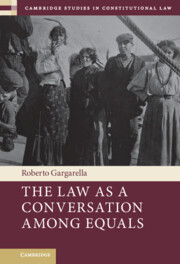Book contents
- The Law As a Conversation among Equals
- Cambridge Studies in Constitutional Law
- The Law As a Conversation among Equals
- Copyright page
- Contents
- Preface
- Acknowledgments
- 1 Constitutionalism and Democracy
- 2 The Law As Conversation among Equals
- 3 “Democratic Dissonance”
- 4 A Constitution Marked by a “Discomfort with Democracy”
- 5 Motivations and Institutions: “If Men Were Angels”
- 6 The Structural Difficulties of Representation
- 7 The Rise and Fall of Popular Control
- 8 The Periodic Vote, or “Electoral Extortion”
- 9 Checks and Balances
- 10 Presidentialism
- 11 Rights
- 12 Social Rights and the “Engine Room”
- 13 Judicial Review
- 14 Constitutional Interpretation
- 15 Constitution Making
- 16 The Birth of Dialogical Constitutionalism
- 17 Why We Care About Dialogue
- 18 “Democratic Erosion”
- 19 The New Deliberative Assemblies
- 20 Conclusion
- Bibliography
- Index
12 - Social Rights and the “Engine Room”
Published online by Cambridge University Press: 25 April 2022
- The Law As a Conversation among Equals
- Cambridge Studies in Constitutional Law
- The Law As a Conversation among Equals
- Copyright page
- Contents
- Preface
- Acknowledgments
- 1 Constitutionalism and Democracy
- 2 The Law As Conversation among Equals
- 3 “Democratic Dissonance”
- 4 A Constitution Marked by a “Discomfort with Democracy”
- 5 Motivations and Institutions: “If Men Were Angels”
- 6 The Structural Difficulties of Representation
- 7 The Rise and Fall of Popular Control
- 8 The Periodic Vote, or “Electoral Extortion”
- 9 Checks and Balances
- 10 Presidentialism
- 11 Rights
- 12 Social Rights and the “Engine Room”
- 13 Judicial Review
- 14 Constitutional Interpretation
- 15 Constitution Making
- 16 The Birth of Dialogical Constitutionalism
- 17 Why We Care About Dialogue
- 18 “Democratic Erosion”
- 19 The New Deliberative Assemblies
- 20 Conclusion
- Bibliography
- Index
Summary
This chapter is dedicated to the study of social rights. The chapter takes the Mexican 1917 Constitution as the one that set the example for a new “model” of constitutionalism, which was set in motion in the early 20th Century, namely social rights constitutionalism. Constitutions organized under this new paradigm -I maintain- appeared as having “two souls” In what regards their organization of power, these Constitutions maintained the principles of the typical 19th-century conservative model: they were elitist Constitutions that concentrated power in the hands of a few. By contrast, and in what regards their declaration of rights, these new Constitutions appeared to be generous (in the amount of rights that they consecrated), progressive and democratic, just like the Mexican 1917 Constitution. In spite of their promises -I claim- these new documents kept the “engine room” of the Constitution (basically, the organization of power) unchanged and in line with their 19th Century antecedents, and in this way favored the establishment of authoritarian governments.
Keywords
- Type
- Chapter
- Information
- The Law As a Conversation among Equals , pp. 166 - 182Publisher: Cambridge University PressPrint publication year: 2022

